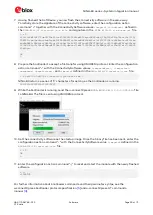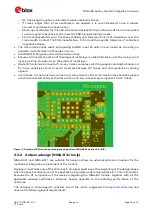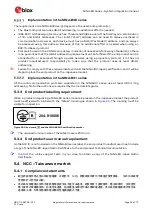
NINA-B3 series - System integration manual
UBX-17056748 - R13
Design-in
Page 42 of 72
C1-Public
3.7.2
Module placement
•
Accessory parts like bypass capacitors should be placed as close as possible to the module to
improve filtering capability, prioritizing the placement of the smallest size capacitor close to
module pads.
⚠
Particular care should be taken not to place components close to the antenna area. The designer
should carefully follow the recommendations from the antenna manufacturer about the distance
of the antenna vs. other parts of the system. The designer should also maximize the distance of
the antenna to Hi-frequency buses like DDRs and related components or consider an optional
metal shield to reduce interferences that could be picked up by the antenna thus reducing the
module’s sensitivity.
•
An optimized module placement allows better RF performance. For more information on antenna
considerations and module placement, see also
3.7.3
Layout and manufacturing
•
Avoid stubs on high-speed signals. Even through-hole vias may have an impact on signal quality.
•
Verify the recommended maximum signal skew for differential pairs and length matching of
buses.
•
Minimize the routing length; longer traces will degrade signal performance. Ensure that the
maximum allowable length for high-speed buses is not exceeded.
•
Ensure that you track your impedance matched traces. Consult with your PCB manufacturer early
in the project for proper stack-up definition.
•
RF and digital sections should be clearly separated on the board.
•
Ground splitting is not allowed below the module.
•
Minimize the bus length to reduce potential EMI issues from digital buses.
•
All traces (including low speed or DC traces) must couple with a reference plane (GND or power);
Hi-speed buses should be referenced to the ground plane. In this case, if the designer needs to
change the ground reference, an adequate number of GND vias must be added in the area of
transition to provide a low impedance path between the two GND layers for the return current.
•
Hi-Speed buses are not allowed to change reference plane. If a reference plane change is
unavoidable, some capacitors should be added in the area to provide a low impedance return path
through the different reference planes.
•
Trace routing should keep a distance greater than 3w from the ground plane routing edge.
•
Power planes should keep a distance from the PCB edge sufficient to route a ground ring around
the PCB, and the ground ring must then be connected to other layers through vias.
3.8
Module footprint and paste mask
The mechanical outline of the NINA-B3 series module can be found in the NINA-B3 series data sheet
. The proposed land pattern layout reflects the pad’s layout of the module.
The Non Solder Mask Defined (NSMD) pad type is recommended over the Solder Mask Defined (SMD)
pad type, which implements the solder mask opening 50
μ
m larger per side than the corresponding
copper pad.
The suggested paste mask layout for the NINA-B3 series modules is to follow the copper mask layout
as described in the NINA-B3 series data sheet
⚠
These are recommendations only and not specifications. The exact mask geometries, distances,
and stencil thicknesses must be adapted to the specific production processes of the customer.
















































